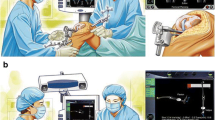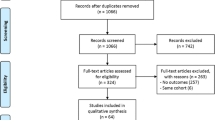Abstract
Potential advantages of minimally invasive total knee arthroplasty (TKA) include decreased pain, faster recovery, and increased quadriceps muscle strength. Computer-assisted navigation has been associated with more accurate component alignment. We evaluated two groups of 50 patients who had minimally invasive TKAs performed with and without navigation by two surgeons. A comparison of 50 previous TKAs by each of the two surgeons showed similar results. The mean operative times for the navigation and nonnavigation groups were 112 minutes (range, 63–297 minutes) and 54 minutes (range, 35–86 minutes), respectively. The mean estimated blood losses, mean Knee Society pain as well as functional scores and mean component alignments were similar. The number of knees that deviated by more than 3° from the normal anatomic axis was three and one in the navigated and nonnavigated groups, respectively. Complication rates were 6% and 4% in the navigated and nonnavigated groups, respectively. Our data demonstrate no distinct advantage of navigation when combined with a minimally invasive approach.
Level of Evidence: Level II, therapeutic study. See the Guidelines for Authors for a complete description of levels of evidence.
Similar content being viewed by others
References
Bejek Z, Solyom L, Szendroi M. Experiences with computer navigated total knee arthroplasty. Int Orthop. 2007;31:617–622.
Bonutti PM, Mont MA, McMahon M, Ragland PS, Kester M. Minimally invasive total knee arthroplasty. J Bone Joint Surg Am. 2004;86(Suppl 2):26–32.
Bonutti PM, Neal DJ, Kester MA. Minimal incision total knee arthroplasty using the suspended leg technique. Orthopedics. 2003;26:899–903.
Buckup K, Linke LC, Hahne V. Minimally invasive implantation and computer navigation for a unicondylar knee system. Orthopedics. 2007;30:66–69.
Buechel FF Sr, Buechel FF Jr, Pappas MJ, Dalessio J. Twenty-year evaluation of the New Jersey LCS Rotating Platform Knee Replacement. J Knee Surg. 2002;15:84–89.
Chin PL, Foo LS, Yang KY, Yeo SJ, Lo NN. Randomized controlled trial comparing the radiologic outcomes of conventional and minimally invasive techniques for total knee arthroplasty. J Arthroplasty. 2007;22:800–806.
Ensini A, Catani F, Leardini A, Romagnoli M, Giannini S. Alignments and clinical results in conventional and navigated total knee arthroplasty. Clin Orthop Relat Res. 2007;457:156–162.
Esler CN, Lock K, Harper WM, Gregg PJ. Manipulation of total knee replacements. Is the flexion gained retained? J Bone Joint Surg Br. 1999;81:27–29.
Ewald FC. The Knee Society total knee arthroplasty roentgenographic evaluation and scoring system. Clin Orthop Relat Res. 1989;248:9–12.
Gioe TJ, Sinner P, Mehle S, Ma W, Killeen KK. Excellent survival of all-polyethylene tibial components in a community joint registry. Clin Orthop Relat Res. 2007;464:88–92.
Haas SB, Manitta MA, Burdick P. Minimally invasive total knee arthroplasty: the mini midvastus approach. Clin Orthop Relat Res. 2006;452:112–116.
Huang HT, Su JY, Chang JK, Chen CH, Wang GJ. The early clinical outcome of minimally invasive quadriceps-sparing total knee arthroplasty: report of a 2-year follow-up. J Arthroplasty. 2007;22:1007–1012.
Insall JN, Dorr LD, Scott RD, Scott WN. Rationale of the Knee Society clinical rating system. Clin Orthop Relat Res. 1989;248:13–14.
Ito J, Koshino T, Okamoto R, Saito T. 15-year follow-up study of total knee arthroplasty in patients with rheumatoid arthritis. J Arthroplasty. 2003;18:984–992.
Jeffery RS, Morris RW, Denham RA. Coronal alignment after total knee replacement. J Bone Joint Surg Br. 1991;73:709–714.
Jenny JY, Muller PE, Weyer R, John M, Weber P, Ciobanu E, Schmitz A, Bacher T, Neumann W, Jansson V. Navigated minimally invasive unicompartmental knee arthroplasty. Orthopedics. 2006;29:S117–121.
Jung HJ, Jung YB, Song KS, Park SJ, Lee JS. Fractures associated with computer-navigated total knee arthroplasty. A report of two cases. J Bone Joint Surg Am. 2007;89:2280–2284.
Keating EM, Ritter MA, Harty LD, Haas G, Meding JB, Faris PM, Berend ME. Manipulation after total knee arthroplasty. J Bone Joint Surg Am. 2007;89:282–286.
Kim YH, Kim JS, Yoon SH. Alignment and orientation of the components in total knee replacement with and without navigation support: a prospective, randomised study. J Bone Joint Surg Br. 2007;89:471–476.
King J, Stamper DL, Schaad DC, Leopold SS. Minimally invasive total knee arthroplasty compared with traditional total knee arthroplasty. Assessment of the learning curve and the postoperative recuperative period. J Bone Joint Surg Am. 2007;89:1497–1503.
Lampe F, Bohlen K, Dries SP, Sufi-Siavach A, Hille E. Accuracy of implant alignment and early results after minimally invasive vs conventional OrthoPilot-navigated Columbus TKA. Orthopedics. 2007;30:S107–111.
Macule-Beneyto F, Hernandez-Vaquero D, Segur-Vilalta JM, Colomina-Rodriguez R, Hinarejos-Gomez P, Garcia-Forcada I, Seral Garcia B. Navigation in total knee arthroplasty. A multicenter study. Int Orthop. 2006;30:536–540.
Maloney WJ. The stiff total knee arthroplasty: evaluation and management. J Arthroplasty. 2002;17:71–73.
Matsumoto T, Tsumura N, Kurosaka M, Muratsu H, Yoshiya S, Kuroda R. Clinical values in computer-assisted total knee arthroplasty. Orthopedics. 2006;29:1115–1120.
Matziolis G, Krocker D, Weiss U, Tohtz S, Perka C. A prospective, randomized study of computer-assisted and conventional total knee arthroplasty. Three-dimensional evaluation of implant alignment and rotation. J Bone Joint Surg Am. 2007;89:236–243.
Mauerhan DR, Mokris JG, Ly A, Kiebzak GM. Relationship between length of stay and manipulation rate after total knee arthroplasty. J Arthroplasty. 1998;13:896–900.
McAllister CM, Stepanian JD. The impact of minimally invasive surgical techniques on early range of motion after primary total knee arthroplasty. J Arthroplasty. 2008;23:10–18.
Meding JB, Keating EM, Ritter MA, Faris PM, Berend ME. Long-term followup of posterior-cruciate-retaining TKR in patients with rheumatoid arthritis. Clin Orthop Relat Res. 2004;428:146–152.
Mombert M, Van Den Daelen L, Gunst P, Missinne L. Navigated total knee arthroplasty: a radiological analysis of 42 randomised cases. Acta Orthop Belg. 2007;73:49–54.
Namba RS, Inacio M. Early and late manipulation improve flexion after total knee arthroplasty. J Arthroplasty. 2007;22:58–61.
Novak EJ, Silverstein MD, Bozic KJ. The cost-effectiveness of computer-assisted navigation in total knee arthroplasty. J Bone Joint Surg Am. 2007;89:2389–2397.
Rand JA, Coventry MB. Ten-year evaluation of geometric total knee arthroplasty. Clin Orthop Relat Res. 1988;232:168–173.
Scuderi GR, Tenholder M, Capeci C. Surgical approaches in mini-incision total knee arthroplasty. Clin Orthop Relat Res. 2004;428:61–67.
Seon JK, Song EK. Navigation-assisted less invasive total knee arthroplasty compared with conventional total knee arthroplasty: a randomized prospective trial. J Arthroplasty. 2006;21:777–782.
Seon JK, Song EK, Yoon TR, Park SJ, Bae BH, Cho SG. Comparison of functional results with navigation-assisted minimally invasive and conventional techniques in bilateral total knee arthroplasty. Comput Aided Surg. 2007;12:189–193.
Seyler TM, Bonutti PM, Ulrich SD, Fatscher T, Marker DR, Mont MA. Minimally invasive lateral approach to total knee arthroplasty. J Arthroplasty. 2007;22:21–26.
Tashiro Y, Miura H, Matsuda S, Okazaki K, Iwamoto Y. Minimally invasive versus standard approach in total knee arthroplasty. Clin Orthop Relat Res. 2007;463:144–150.
Tria AJ Jr. Minimally invasive total knee arthroplasty: the importance of instrumentation. Orthop Clin North Am. 2004;35:227–234.
Watanabe H, Akizuki S, Takizawa T. Survival analysis of a cementless, cruciate-retaining total knee arthroplasty. Clinical and radiographic assessment 10 to 13 years after surgery. J Bone Joint Surg Br. 2004;86:824–829.
Yercan HS, Sugun TS, Bussiere C, Ait Si Selmi T, Davies A, Neyret P. Stiffness after total knee arthroplasty: prevalence, management and outcomes. Knee. 2006;13:111–117.
Zorman D, Etuin P, Jennart H, Scipioni D, Devos S. Computer-assisted total knee arthroplasty: comparative results in a preliminary series of 72 cases. Acta Orthop Belg. 2005;71:696–702.
Acknowledgments
We thank Lindsay Rudert and Gina Zerrusen for compiling the data for this report.
Author information
Authors and Affiliations
Corresponding author
Additional information
One or more of the authors (PMB, DAD, MAM) are consultants for and receive funding from Stryker.
Each author certifies that his or her institution has approved the human protocol for this investigation, that all investigations were conducted in conformity with ethical principles of research, and that informed consent for participation in the study was obtained.
About this article
Cite this article
Bonutti, P.M., Dethmers, D.A., McGrath, M.S. et al. Navigation Did Not Improve the Precision of Minimally Invasive Knee Arthroplasty. Clin Orthop Relat Res 466, 2730–2735 (2008). https://doi.org/10.1007/s11999-008-0359-4
Received:
Accepted:
Published:
Issue Date:
DOI: https://doi.org/10.1007/s11999-008-0359-4




